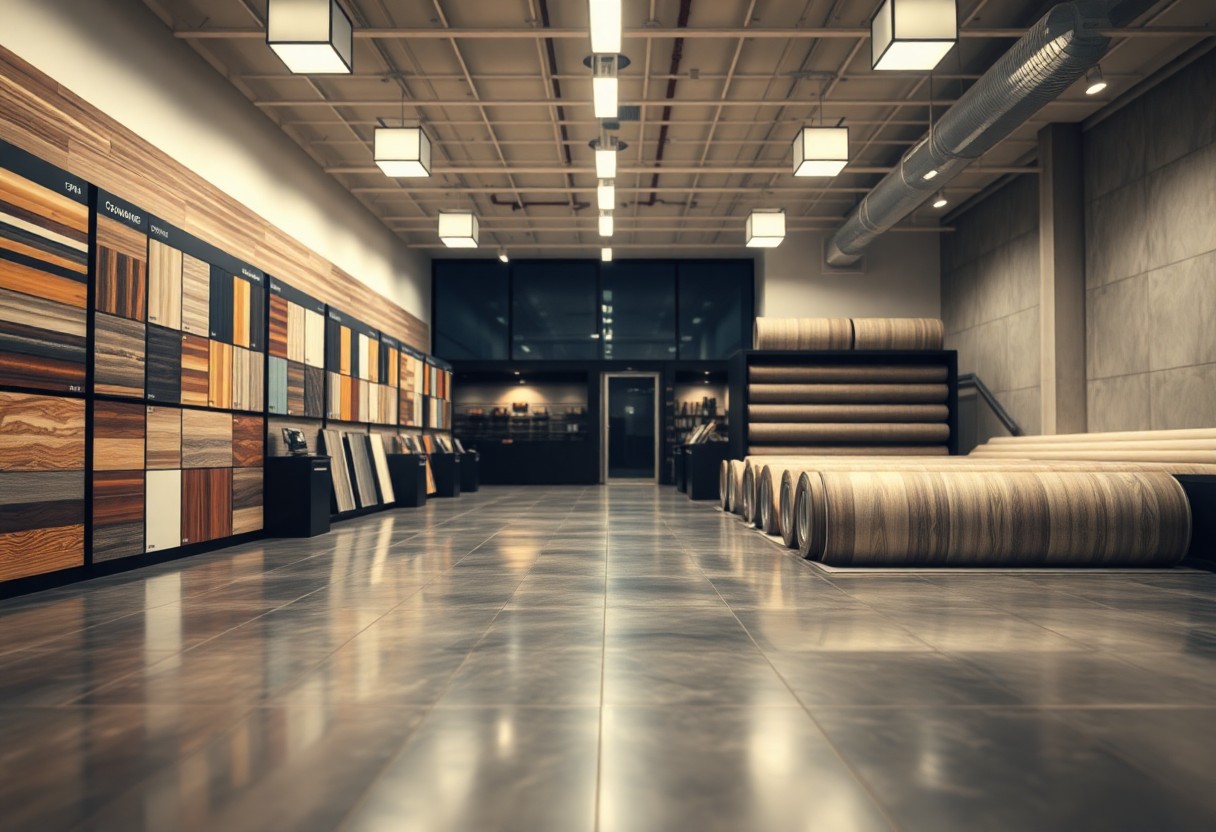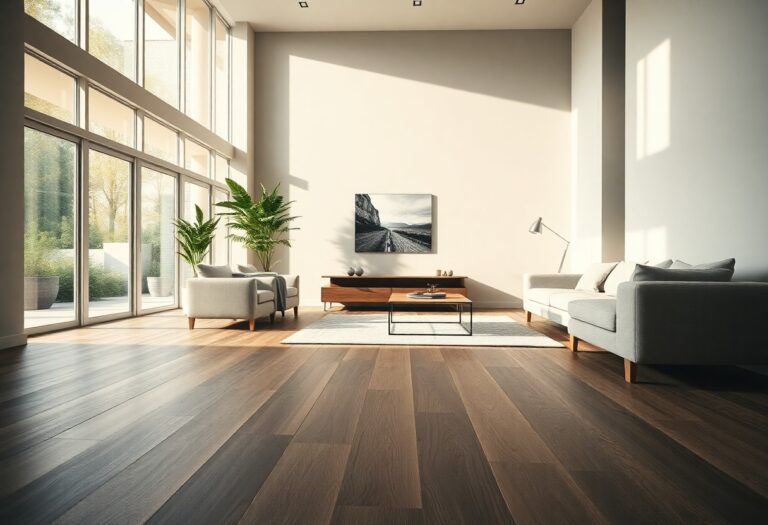There’s a wide array of flooring options available, and when it comes to vinyl, you may find yourself torn between SPC (Stone Plastic Composite) and Dry Back vinyl. In this guide, you will explore the key differences, benefits, and considerations of each flooring type, helping you make an informed decision that best suits your needs, lifestyle, and budget. Whether you’re looking for durability or comfort, understanding these options will empower you to enhance your space effectively.
Types of Vinyl Flooring
When considering vinyl flooring, you encounter two primary types: SPC Vinyl and Dry Back Vinyl. Each offers distinct characteristics suitable for various applications.
- SPC Vinyl: Rigid core, high durability
- Dry Back Vinyl: Traditional glue-down installation
- Water Resistance: Both types perform well
- Cost Range: Varies based on quality
- Sound Absorption: SPC generally quieter
Recognizing the differences can significantly influence your flooring choice based on your lifestyle and needs.
| Type | Key Features |
|---|---|
| SPC Vinyl | Rigid core, highly durable, waterproof |
| Dry Back Vinyl | Glue-down method, versatile aesthetics |
| Water Resistance | Both types are water-resistant |
| Installation Method | SPC is often floating; Dry Back is glued |
| Maintenance | Low maintenance for both options |
SPC Vinyl Flooring
SPC Vinyl flooring features a solid core structure, making it incredibly durable and resistant to dents and impacts. Its waterproof nature makes it ideal for high-moisture areas like kitchens and bathrooms. You will appreciate its ease of installation, which often employs a click-lock system, allowing for a DIY project with minimal hassle.
Dry Back Vinyl Flooring
Dry Back Vinyl flooring adheres directly to the subfloor, offering a stable and solid feel. This type is highly versatile in terms of design, making it suitable for both residential and commercial use. You can select from various colors and textures to achieve your desired aesthetic.
With Dry Back Vinyl, the installation involves applying adhesive over the subfloor and laying the planks down carefully. This method ensures a strong bond and helps eliminate movement, making it appropriate for spaces with heavy foot traffic. When installed correctly, this option can last for decades, proving itself as a reliable choice for any space.
Pros and Cons
| SPC Vinyl | Dry Back Vinyl |
|---|---|
| Durable and water-resistant | Highly customizable with designs |
| Easy to install with click-lock systems | Cost-effective for large areas |
| Sound insulation properties | Natural look and feel |
| Stable in high moisture environments | Can typically be repaired easily |
| May feel less like real wood or stone | Requires more adhesive and prep work |
| Limited design options compared to dry back | More prone to scratches and dents |
Advantages of SPC Vinyl
SPC vinyl flooring is known for its exceptional durability and water resistance, making it ideal for homes with pets or high humidity levels. Its solid core construction offers stability, which minimizes expansion and contraction, ensuring long-lasting performance.
Disadvantages of SPC Vinyl
Despite its benefits, SPC vinyl can be less visually authentic than options like dry back vinyl. The range of designs available may also be limited compared to other flooring types, impacting your customization choices.
Additionally, although SPC is sturdy, it may feel firmer underfoot and less like natural wood or stone, which can detract from the comfort and warmth some homeowners prefer. Scratches can also be more visible on its surface, which is a consideration for high-traffic areas.
Advantages of Dry Back Vinyl
Dry back vinyl flooring offers outstanding design versatility, allowing you to choose from a broad range of colors and patterns that mimic natural materials. It’s also a cost-effective solution for covering large spaces while providing a classic appearance.
In terms of practicality, dry back vinyl is easier to repair in case of damage. Its glue-down installation provides a secure fit, which can enhance the overall performance and longevity of the flooring. This makes it suitable for both residential and commercial applications.
Disadvantages of Dry Back Vinyl
On the downside, dry back vinyl requires a more complex installation process involving adhesives, which can increase labor costs and time. Additionally, it is generally more susceptible to scratches and dents than SPC vinyl due to its softer construction.
This vulnerability can lead to visible wear over time, especially in high-traffic areas, necessitating regular maintenance. Moreover, the gluing process can pose challenges in areas with high moisture unless appropriate adhesives are used, adding an element of caution during installation.

Key Factors to Consider
When deciding between SPC vinyl and dry back vinyl flooring, you’ll want to evaluate several key factors that can impact your choice and satisfaction. Consider the following:
- Durability and Maintenance
- Cost and Budget
- Aesthetics and Design Options
This assessment will help you make an informed decision that aligns with your needs and lifestyle.
Durability and Maintenance
Both SPC vinyl and dry back vinyl flooring are designed to withstand wear and tears, but SPC generally offers superior durability due to its rigid core. You’ll find SPC is less prone to denting and scratching, making it ideal for high-traffic areas. Maintenance is straightforward for both types, requiring only regular sweeping and occasional mopping to maintain their appearance.
Cost and Budget
Your budget will play a significant role in choosing between SPC and dry back vinyl flooring. SPC vinyl typically comes at a higher price point, reflecting its robust features, while dry back options can be more budget-friendly. You should also consider installation costs, as they can vary significantly depending on the flooring type.
SPC vinyl flooring generally costs between $2.50 to $5.00 per square foot, including installation, while dry back vinyl ranges from $1.50 to $3.50 per square foot. Evaluating your overall financial plan is necessary, as investing in higher-quality flooring may yield better long-term benefits.
Aesthetics and Design Options
Both SPC and dry back vinyl offer a wide range of colors and styles, allowing you to match your flooring with your interior design vision. SPC vinyl often features more intricate textures and designs, mimicking natural materials like hardwood and stone. In contrast, dry back vinyl provides a more basic style option but can still deliver excellent aesthetic results.
SPC’s thicker design allows for added texture, letting you capture the look of reclaimed wood or distressed stone with stunning realism, while dry back options excel in producing vibrant colors and patterns. Exploring samples can help you visualize how either choice will enhance your space.
Tips for Choosing the Right Flooring
- Evaluate the room’s function and traffic level.
- Consider your climate and moisture levels.
- Research design trends that suit your style.
- Look into installation requirements and options.
Assume that these factors will shape your decision significantly.
Assessing Your Needs
Start by understanding the specific requirements of your space. Consider aspects like foot traffic, type of activities taking place, and potential exposure to moisture. For high-traffic areas, SPC vinyl’s durability may be ideal, while dry back vinyl might suffice in low-traffic, more controlled environments. Analyze how frequently you’ll clean the floors and if you need a surface that’s easy to maintain.
Budgeting Wisely
Your budget plays a vital role in your flooring choice. SPC vinyl typically has a higher upfront cost compared to dry back vinyl, but its long-term durability can lead to savings on replacements and repairs. Factor in additional costs such as underlayment, installation fees, and potential maintenance needs. By calculating all associated expenses, you can find an option that fits your financial plan without sacrificing quality.
Expanding your budget to include installation should not be overlooked. Professional installation can ensure a flawless finish and longer lifespan for both types of flooring. The difference in pricing can vary greatly based on geographical location and the complexity of the installation process, with SPC typically requiring more specialized techniques. Budgeting for unexpected expenses can prevent financial strain, ensuring that your chosen flooring will meet both aesthetic and functional needs for years to come.
Step-by-Step Installation Guide
| Step | Description |
| 1. Preparing the Subfloor | Ensure the subfloor is clean, dry, and level. Remove any old flooring and debris. |
| 2. Gathering Tools and Materials | Collect necessary tools like a utility knife, measuring tape, and spacers. |
| 3. Installing the Flooring | Follow the manufacturer’s instructions for proper installation technique. |
| 4. Finishing Touches | Install baseboards and transition strips to complete the look. |
Preparing the Subfloor
Begin by inspecting your subfloor for imperfections, such as cracks or uneven surfaces. Clean the area thoroughly to remove dust and debris, and ensure it’s completely dry. If necessary, level the subfloor with a compound, allowing ample drying time before proceeding.
Installation Process
Start by laying out the vinyl planks according to your room’s dimensions. Working from the longest wall, begin installing the first row, using spacers to maintain expansion gaps. Ensure each plank clicks securely into place for a seamless finish.
When installing, alternate the plank lengths to create a more natural look and reduce the risk of visible seams. Use a utility knife for precise cuts around door frames and edges. Ensuring tight seams will prevent moisture or dirt from infiltrating, which is vital for longevity.
Finishing Touches
Once the installation is complete, remove any spacers, and carefully install baseboards and transition strips along doorways and edges to enhance the aesthetic appeal. Caulk any necessary gaps for a polished finish.
These finishing touches not only cover expansion gaps but also add a professional look to your room. Ensure that everything is securely fastened and aligned, leaving you with a clean, durable flooring installation ready to withstand everyday use.
Summing up
As a reminder, choosing between SPC vinyl and dry back vinyl flooring depends on your specific needs and preferences. Consider factors like moisture resistance, installation method, and durability to determine which option suits your lifestyle best. SPC vinyl offers enhanced stability and ease of installation, while dry back vinyl can provide a more traditional feel. Evaluate your space and usage to ensure you make an informed decision that aligns with your style and practical requirements.





